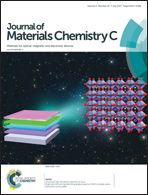Tunable defect engineering in TiON thin films by multi-step sputtering processes: from a Schottky diode to resistive switching memory†
Abstract
The role of defect engineering is essential in resistive switching memory. In this study, multi-step sputtering processes to fabricate TiON for a resistive random access memory (ReRAM) device were demonstrated and detailed mechanisms were systematically investigated. The multi-step sputtered TiON film shows asymmetric defect distribution, exhibiting rectifying characteristics as a Schottky diode and resistive switching behavior as memory, depending on the applied bias. Rectifying properties, including a rectifying ratio of 102 at ±1.5 V, a forward current of ∼2 mA at 1.5 V, a turn-on voltage of 1.5 V and an ideality factor of 4.5, were measured. In addition, compared to a TiON ReRAM device prepared via a single-step sputtering process, TiON film with a gradient distribution of defects exhibits stable switching behavior with a better uniform SET voltage (VSET) and a coefficient of variation (σ/μ) which improves from 0.49 to 0.17. The conduction mechanisms of two kinds of device were investigated via a trap-controlled space charge limit conduction (SCLC) process. The mechanisms of how the distribution of asymmetric defects affects the resistive switching behavior were discussed in detail. The results disclose the possibility of the modulation of defect engineering toward Schottky diode applications, leading to the improvement of ReRAM performance for one-diode one-resistor (1D1R) applications in the future.



 Please wait while we load your content...
Please wait while we load your content...